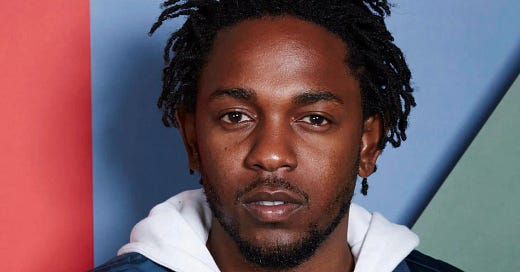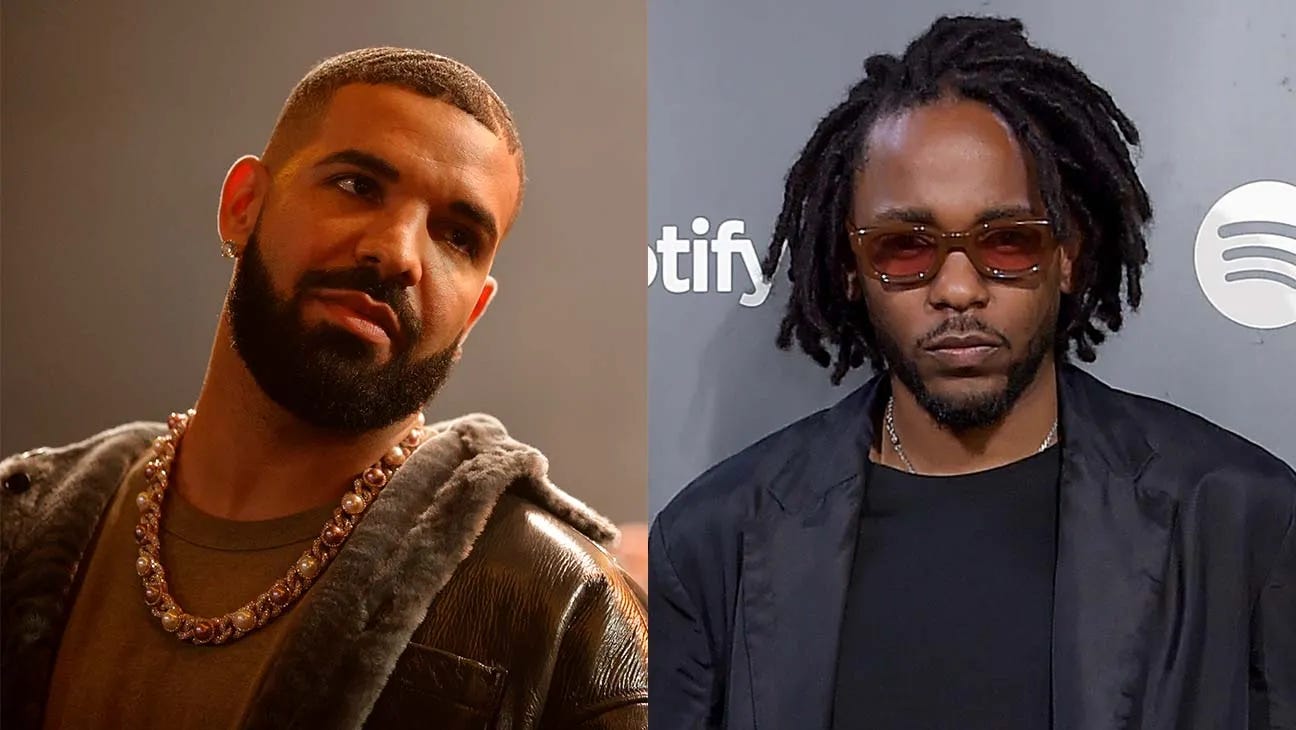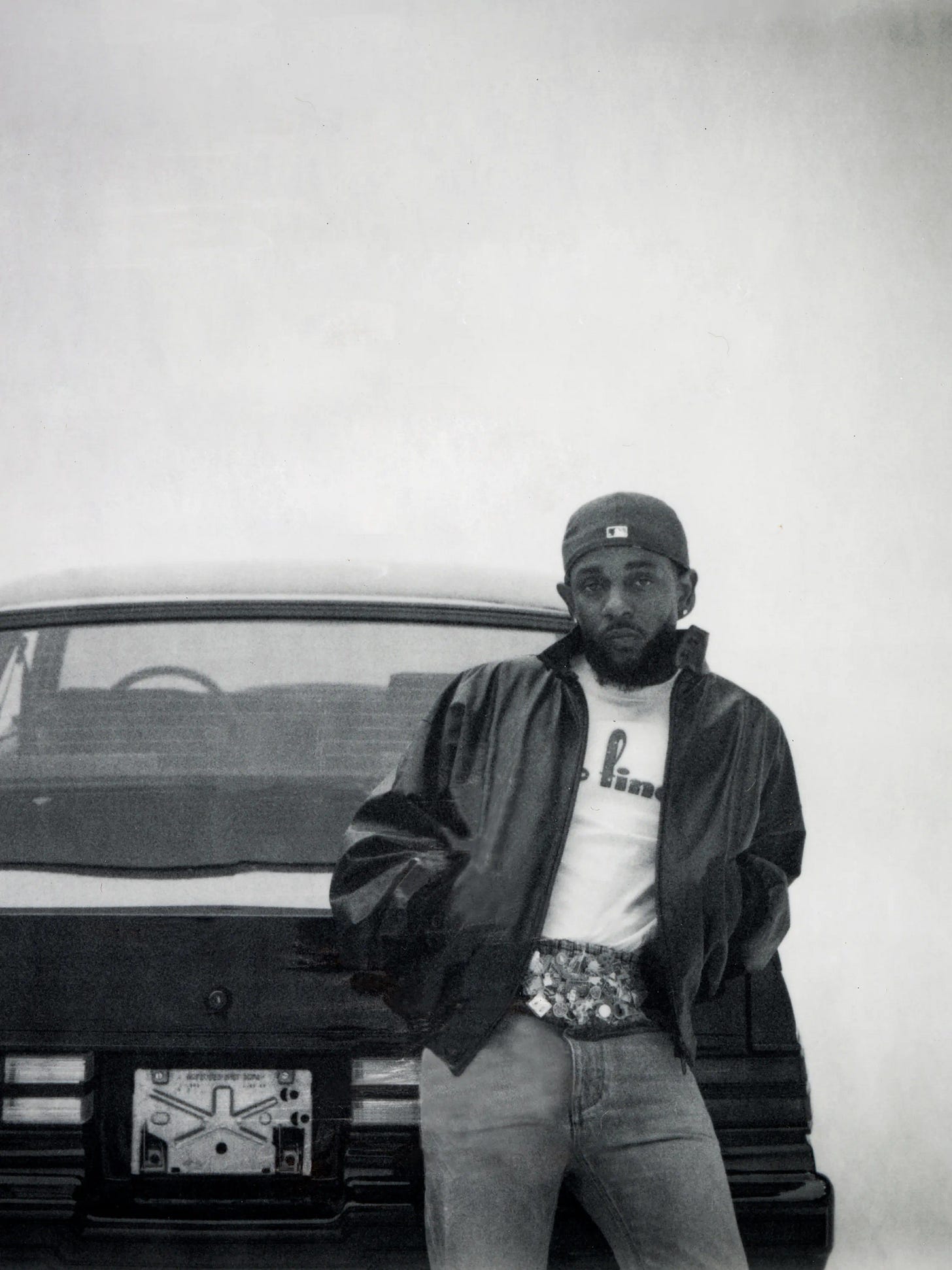Kendrick Lamar
I was first introduced to Kendrick Lamar in 2011 after hearing massive underground rumblings about a “great new rapper from Compton”. I picked up his breakthrough self-released mixtape “Section 80” which revealed Kendrick to be a diamond in the rough with tracks like “A.D.H.D.” and “Hol’ Up” which displayed his lyrical skill and vision beyond the (lower) budget. He was then discovered by L.A. rap legend Dr. Dre and released his first major label album “Good Kid, m.A.A.d. City” the following year. G.K.M.C. was a concept album examining growing up/life in Compton intersecting with gang culture with a critical eye. It was met with massive critical acclaim as the higher production values meshed well with Kendrick’s thoughtful lyrics and intricate rhyme flows.
After such a grassroots boom-bap “dope beats, dope rhymes” album with minor stabs at hits, I was expecting his next album to be more commercial. “To Pimp a Butterfly” was released in 2015 and delved deeper into Kendrick’s artsier side, with even less commercial appeal, with songs like “For Free?” where he rapped over the free jazz saxophone of Kamasi Washington. The album was a concept album about the Black experience in America, the trappings of fame and fortune, colorism within the Black community and more. Released during the rise of the Black Lives Matter movement, tracks like the uplifting “Alright” resonated with fans and solidified Kendrick as one of the more (most?) popular “conscious” mainstream rappers during the 2010s when that genre was declining in popularity and most hip hop fans were chanting “Molly… molly… Percocet” along with Future.
Lamar’s next album, “Damn” earned a Pulitzer Prize, a first for the hip hop genre, while leaning into more commercial territory with tracks featuring Rihanna and U2. His next album “Mr. Morale and the Big Steppers” was a sprawling, 70+ minute, inwardly-focused journey recorded mostly during the global Covid pandemic. Here Kendrick grappled with fame, change, spiritual growth and, most importantly, his struggles with a savior complex. Narrated by German spiritual teacher Eckhart Tolle, Mr. Morale was a brave, contemplative, therapeutic self-analysis.
Drake/Kendrick Lamar
Enter the Drake/Kendrick Lamar battle of 2024.
Drake and Kendrick had collaborated on one of Lamar’s early singles, “Poetic Justice” in 2012 but over time, things clearly soured. In 2015, Kendrick declared on his single “King Kunta”: “A rapper with a ghostwriter? What the fuck happened?” I didn’t know who he was talking about at the time, but now it kinda makes sense, as Drake was famously accused of exactly that (a no-no in hip hop) soon afterwards. The beef subliminally bubbled under the radar for over a decade as we fast forward to 2024, when the mentions in songs became more overt and the beef went public.
Drake lobbed a fun but formidable diss at Lamar called “Push Ups”, a well-crafted athletic lyrical workout, then followed up with another track “Family Matters”, which he seemed to think would finish Lamar off, but he didn’t reveal any quality shots except for speculation and childish jabs (“Your partner is probably cheating on you”, “You’re short”???). Lamar then retaliated with an arsenal of tracks, including the lethal killshot “Not Like Us” which essentially ostracized Drake from hip hop culture by labeling him a colonizer and pedophile. Kendrick clinically dissected every aspect of Drake’s upbringing, character, life, parenting style, relationship to hip hop and Black culture in general, leaving him (figuratively) battered and bruised, with no good next move within the battle or his career in general. It’s notable that Drake’s post-battle single “No Face” shows him rapping tough while he and his (ahem) “goons” drive ATVs ominously around inside a deserted Toronto mall at night. It looked like something a bunch of teenagers would do and could maybe pull off, not a bunch of guys pushing 40.
Kendrick Lamar “GNX” album cover
On the latest Lamar album “GNX” released in late November, Drake is not mentioned (by name at least) and even talk of the beef is thankfully minimized because, ultimately Kendrick doesn’t really need Drake or beef to create compelling music or sell records. GNX is different than past Lamar albums, which were much longer, sprawling conceptual opuses, most over an hour. This new album is in a different weight class, clocking in at a lean 44 minutes.
On the dramatic opener, “Wacced Out Murals” Kendrick hasn’t sounded this cinematic, foreboding, ominous or menacing since his 2012 paranoid gang ode “m.A.A.d. City”. As the track builds across the 5+ minutes with Kendrick spitting lyrics through gritted teeth, mid-song he raps “Fuck a double entendre, I want y’all to feel this shit”, which sets the tone for the album. Where his last release “Mr. Morale…” was a lengthy masterful chronicle and examination of his personal growth through adversity narrated by German spiritual teacher Eckhart Tolle, GNX ranks as the most musically and lyrically direct Kendrick album. Gone are the near 7 minute self-examination sessions, interludes from self-help gurus and lyrics about intermittent fasting. Those past aspects have been replaced by shorter, punchier West Coast jams with more in-your-face lyrical content. In fact, some of the tracks are so concise (for Kendrick) that they feel a little like interludes.
“Wacced Out Murals” leads into the bouncy “Squabble Up”, based on the 80s Debbie Deb dance track “When I Hear Music”. The track shows Lamar experimenting playfully with flows, inflections and even verbal sound effects, all set to an unapologetically West Coast soundtrack. The accompanying video reads like a love letter to California hip hop culture, with scenes referencing the iconic Ice T “Power” record cover, crumping, scraper bikes, Isaac Hayes and more.
”Luther” turns the heat down with a thumping love song featuring SZA built on a (surprise!) Luther Vandross sample. It’s smooth for sure, but, again, feels shorter, clocking in at just under three minutes. Kendrick has executed tracks which build in the past, but the next track “Man at the Garden” reveals strong echoes of Nas’s 2001 track “One Mic”. Lyrically, Kendrick is clearly feeling himself and his place in hip hop, celebrating his work ethic and declaring “I deserve it all” over and over. The meritocratic angle is a little different from the Kendrick that we’re used to, as he usually preaches humility and was very reticent to accept his “savior” status on Mr. Morale, but his angle here seems to be to inspire others to aspire to greatness.
Lamar’s love and respect for late rapper Tupac Shakur is well-documented, especially on To Pimp a Butterfly’s closing track “Mortal Man”, which featured a lengthy conversation between Lamar and the late Tupac, grafted from an unearthed, unreleased interview. GNX’s track “Reincarnated” is based on Tupac and the Outlawz “Made Ni**as” from the 1997 “Gang Related” movie soundtrack, with Lamar bouncing through the track, sounding more like ‘Pac than ever. Lyrically, he takes on the persona of a couple deceased musicians (John Lee Hooker? Billie Holiday?) then takes the last ⅓ to examine his own motivation as a rapper and as a man.
“Hey Now”, “Peekaboo” and the title track won’t go down as the best Kendrick songs ever but they are formidable, dark, claustrophobic posse cuts featuring a bevy of up-and-coming LA MCs. The lowendy beats knock with keyboard washes, while the rappers spit sharp, gritty street raps.
The second half of the album doesn’t falter and swings up on a high note with some captivating tracks. “TV Off” is sewn from the same material as “Not Like Us” (both produced by LA producer DJ Mustard), a bouncy, choppy, punchy West Coast banger with tension-building beat switches punctuated with Lamar’s blood-curdling scream, “MUSTAAAARRRRDDD!”. When Kendrick re-enters with the Biggie-lifted lines “Ain’t no other kings in this rap thing, they siblings…nothing but my children, one shot, they disappearin’”, you know you’re experiencing a moment. Mainstream hip hop hasn’t sounded this exciting in a while.
Another asset is “Heart Pt. 6”, where Lamar snatches the song title back from Drake, who released a track of the same name during the beef to try to interrupt Kendrick’s “Heart” series . Heart Pt. 6 is a well-structured story-telling song that recalls “Black Boy Fly”, a bonus track on the deluxe edition of Good Kid M.a.a.d. City. Black Boy Fly chronicled Kendrick’s early ambition and frustration as an aspiring rapper from Compton, where he saw very few people from his hood succeeding. Heart Pt. 6 acts as the other half of the bookends, released a dozen years later. Here Kendrick is reflecting on his early days, eating fast food in the studio with the other aspiring L.A. rappers Schoolboy Q, Ab Soul and Jay Rock, lending each other clothes because they were essentially broke. The song is testament to Lamar’s history, work and the people who assisted him to get to where he is today. It’s a well-crafted passionate lyrical moment crafted over a tasteful SWV-sampled beat.
The final track “Gloria” borrows from the same melodies as “Father Time” off Lamar’s last album and is a poetic paean to his own writing, personifying it in the shape of a woman who he’s in a relationship with.
I recently went back and listened to “Section 80” and marveled at Kendrick’s vision, the progress he’s made and was impressed with the body of work he’s created thus far. GNX is another high point in his career; it’s a bit of a left turn, but the boldness, brashness and immediacy makes the project stand out. Again, while Drake isn’t mentioned by name, GNX is clearly a victory lap.





